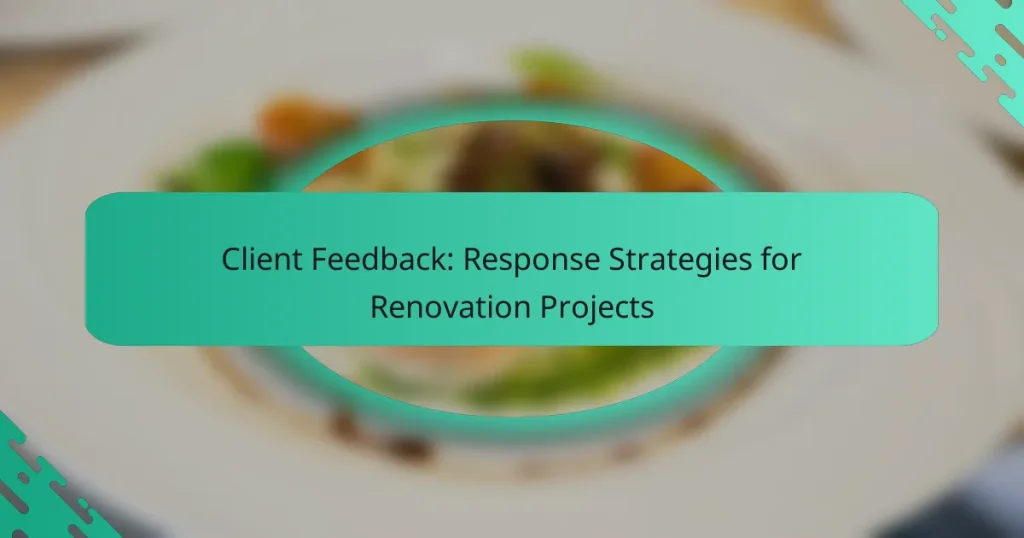Customer satisfaction is crucial in the home improvement industry, as it directly impacts a business’s reputation and client relationships. By prioritizing clear communication, consistent quality, and effective feedback, companies can significantly enhance their service delivery. Understanding key factors such as service quality, timeliness, and cost transparency allows homeowners to make informed choices and ensures a positive experience throughout their projects.
Customer Reviews: Influence on Home Improvement Choices
Customer Feedback: Collection, Analysis and Impact
Customer Expectations: Insights for Home Improvement Services
Client Feedback: Response Strategies for Renovation Projects
Customer Satisfaction Metrics: Evaluation for Home Renovation
Testimonials: Enhancing Your Home Service Business
How to improve customer satisfaction in home improvement services
Improving customer satisfaction in home improvement services involves clear communication, consistent quality, and effective feedback mechanisms. By focusing on these areas, businesses can enhance their reputation and foster long-term relationships with clients.
Effective communication strategies
Clear communication is essential in home improvement projects. Regular updates on project status, timelines, and any changes help manage customer expectations and build trust. Use simple language and avoid jargon to ensure clients fully understand the details.
Consider utilizing multiple communication channels such as phone calls, emails, and messaging apps to cater to customer preferences. Establishing a point of contact for clients can also streamline communication and make them feel valued.
Quality assurance processes
Implementing quality assurance processes ensures that the work meets established standards and customer expectations. Regular inspections during the project can help identify issues early, allowing for timely corrections. This proactive approach can significantly reduce the likelihood of customer complaints.
Consider adopting industry standards or certifications relevant to your area, as these can enhance credibility. For example, following guidelines from local building codes or safety regulations can reassure customers about the quality of the work being performed.
Customer feedback mechanisms
Establishing effective customer feedback mechanisms is crucial for understanding client satisfaction. Surveys, follow-up calls, and online reviews provide valuable insights into areas for improvement. Encourage customers to share their experiences and suggestions after project completion.
Make it easy for clients to provide feedback by offering multiple platforms, such as email, social media, or dedicated feedback forms. Regularly review this feedback to identify trends and implement changes that enhance customer satisfaction in future projects.
What are the key factors influencing customer satisfaction?
Key factors influencing customer satisfaction in home improvement projects include service quality, timeliness of project completion, and cost transparency. Understanding these elements can help homeowners choose the right contractors and ensure a positive experience.
Service quality
Service quality is critical in determining customer satisfaction. It encompasses the professionalism of the contractors, the quality of materials used, and the overall workmanship. Homeowners should look for contractors with strong reviews and a portfolio that demonstrates their expertise.
To assess service quality, consider asking for references and checking online ratings. A reliable contractor should be willing to provide testimonials or examples of past work. Additionally, clear communication throughout the project is essential for maintaining satisfaction.
Timeliness of project completion
Timeliness is another significant factor affecting customer satisfaction. Homeowners expect projects to be completed within the agreed timeframe. Delays can lead to frustration and additional costs, so it’s important to set realistic deadlines from the start.
When hiring a contractor, inquire about their track record for completing projects on time. A good practice is to include specific timelines in the contract and discuss potential penalties for delays. This approach helps ensure accountability and encourages timely completion.
Cost transparency
Cost transparency is vital for customer satisfaction in home improvement projects. Homeowners should receive clear estimates that outline all costs, including materials, labor, and any potential additional fees. This transparency helps avoid surprises and builds trust between the homeowner and contractor.
To ensure cost transparency, request detailed quotes from multiple contractors and compare them. Be wary of estimates that seem significantly lower than others, as they may indicate hidden costs or subpar materials. Always clarify any ambiguous charges before signing a contract to protect your budget.
How can local home improvement businesses enhance their reputation?
Local home improvement businesses can enhance their reputation by actively managing their online presence and engaging with their community. Building trust through transparency and responsiveness is key to attracting and retaining customers.
Online reviews management
Effectively managing online reviews is crucial for local home improvement businesses. Encourage satisfied customers to leave positive feedback on platforms like Google, Yelp, and Facebook, as these reviews significantly influence potential clients’ decisions.
Responding to reviews, both positive and negative, shows that the business values customer feedback. Aim for a response time of less than 24 hours to demonstrate commitment and professionalism.
Community engagement initiatives
Community engagement initiatives help local home improvement businesses build strong relationships with residents. Consider sponsoring local events or participating in community service projects to increase visibility and foster goodwill.
Hosting workshops on home maintenance or DIY projects can also position the business as a knowledgeable resource. This not only enhances reputation but also creates opportunities for networking and referrals.
What are the best practices for handling customer complaints?
Effective handling of customer complaints involves active listening, timely resolutions, and clear communication. Implementing these best practices can significantly enhance customer satisfaction and loyalty.
Active listening techniques
Active listening is crucial for understanding customer complaints fully. This involves giving the customer your full attention, acknowledging their feelings, and paraphrasing their concerns to confirm understanding. Techniques such as nodding, maintaining eye contact, and using verbal affirmations can help convey that you are engaged.
Additionally, avoid interrupting the customer while they are speaking. Allow them to express their thoughts completely before responding. This not only helps in gathering all necessary information but also makes the customer feel valued and heard.
Timely resolution strategies
Timeliness is key when resolving customer complaints. Aim to address issues within a few hours to a couple of days, depending on the complexity. Quick responses can prevent escalation and demonstrate your commitment to customer satisfaction.
Establish a clear process for handling complaints, including designated team members responsible for resolutions. Consider using a tracking system to monitor the status of complaints and ensure follow-ups. This structured approach can help streamline resolutions and improve overall efficiency.
How do customer satisfaction surveys impact service delivery?
Customer satisfaction surveys significantly enhance service delivery by providing direct feedback from clients. This feedback helps businesses identify strengths and weaknesses in their offerings, allowing for targeted improvements that can lead to higher customer retention and loyalty.
Identifying service gaps
Surveys reveal specific areas where service may fall short of customer expectations. For instance, if multiple respondents indicate dissatisfaction with response times, a business can prioritize this issue to enhance efficiency. Regularly analyzing survey results can help pinpoint recurring problems, enabling proactive solutions.
Utilizing open-ended questions in surveys can uncover nuanced insights that quantitative data might miss. This qualitative feedback allows businesses to understand customer sentiments more deeply, leading to more effective service adjustments.
Driving continuous improvement
Customer satisfaction surveys foster a culture of continuous improvement by encouraging businesses to act on feedback. Implementing changes based on survey results can lead to enhanced service quality, which is essential for staying competitive in the market. For example, a home improvement company might adjust its project timelines based on customer feedback regarding delays.
To maintain momentum, businesses should regularly conduct surveys and communicate the changes made as a result. This transparency not only builds trust but also motivates customers to provide ongoing feedback, creating a cycle of improvement that benefits both the company and its clients.
What role does customer education play in satisfaction?
Customer education is crucial for enhancing satisfaction in home improvement projects. By informing clients about processes, materials, and maintenance, they feel more confident and engaged, leading to better outcomes and fewer misunderstandings.
Providing project insights
Offering detailed insights into the project helps customers understand what to expect at each stage. This includes timelines, potential challenges, and the materials being used. For instance, explaining the benefits of using high-quality insulation can justify higher upfront costs while ensuring long-term energy savings.
Regular updates during the project can also keep customers informed and involved. Consider using visual aids, such as timelines or progress photos, to illustrate advancements and maintain transparency.
Offering maintenance tips
Educating customers on maintenance can significantly impact their satisfaction post-project. Providing clear guidelines on how to care for new installations, such as cleaning schedules or recommended products, helps ensure longevity and performance. For example, advising on the best ways to maintain hardwood floors can prevent damage and extend their life.
Additionally, offering seasonal checklists can empower homeowners to take proactive steps in maintaining their improvements. Simple reminders about gutter cleaning or HVAC filter changes can enhance the overall experience and satisfaction with the service provided.
How can technology improve customer satisfaction in home improvement?
Technology enhances customer satisfaction in home improvement by streamlining communication, increasing transparency, and providing innovative solutions. Tools like project management software and customer relationship management systems allow homeowners and contractors to collaborate effectively, ensuring projects meet expectations.
Online Project Management Tools
Online project management tools enable homeowners to track progress, timelines, and budgets in real-time. These platforms often include features like task assignments, document sharing, and progress updates, which keep everyone informed and engaged. Popular options include Trello, Asana, and Monday.com.
Using these tools can reduce misunderstandings and miscommunications, leading to a smoother project experience. Homeowners should choose a platform that fits their needs and offers user-friendly interfaces to maximize engagement.
Virtual Consultations
Virtual consultations provide an efficient way for homeowners to discuss their projects with contractors without needing in-person meetings. This approach saves time and allows for quick adjustments based on feedback. Video conferencing tools like Zoom or Google Meet can facilitate these discussions effectively.
Homeowners should prepare for virtual consultations by gathering relevant documents and images of their spaces. This preparation helps contractors offer tailored advice and solutions, enhancing overall satisfaction.
Customer Feedback Platforms
Customer feedback platforms allow homeowners to share their experiences and rate contractors, fostering accountability and improvement. Tools like SurveyMonkey or Google Forms can be used to gather insights on service quality and project outcomes.
Contractors should actively seek feedback after project completion and use the insights to improve their services. This practice not only enhances customer satisfaction but also builds a positive reputation in the market.






